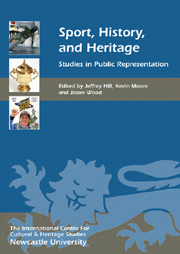Book contents
- Frontmatter
- Contents
- List of Illustrations
- Acknowledgments
- Sport, History and Heritage: An Investigation into the Public Representation of Sport – Editors' General Introduction
- HISTORY, HERITAGE AND SPORT
- MUSEUMS AND THE REPRESENTATION OF SPORT
- SURVIVALS AND LEGACIES: SPORT, HERITAGE AND IDENTITY
- 12 Survivals and Legacies: Sport, Heritage and Identity
- 13 Anfield: Relocating Liverpool's Spiritual Home
- 14 The Canonisation of Common People: Memorialisation and Commemoration in Football
- 15 Heritage, Culture and Identity: The Case of Gaelic Games
- 16 Olympic Heritage – An International Legacy: The Invention of the Modern Olympic Stadium from Coubertin to 1948
- 17 The Indianapolis 500: Making the Pilgrimage to the ‘Yard of Bricks’
- Afterword: History and Heritage in Sport
- List of Contributors
- Index
- HERITAGE MATTERS
14 - The Canonisation of Common People: Memorialisation and Commemoration in Football
from SURVIVALS AND LEGACIES: SPORT, HERITAGE AND IDENTITY
Published online by Cambridge University Press: 05 April 2013
- Frontmatter
- Contents
- List of Illustrations
- Acknowledgments
- Sport, History and Heritage: An Investigation into the Public Representation of Sport – Editors' General Introduction
- HISTORY, HERITAGE AND SPORT
- MUSEUMS AND THE REPRESENTATION OF SPORT
- SURVIVALS AND LEGACIES: SPORT, HERITAGE AND IDENTITY
- 12 Survivals and Legacies: Sport, Heritage and Identity
- 13 Anfield: Relocating Liverpool's Spiritual Home
- 14 The Canonisation of Common People: Memorialisation and Commemoration in Football
- 15 Heritage, Culture and Identity: The Case of Gaelic Games
- 16 Olympic Heritage – An International Legacy: The Invention of the Modern Olympic Stadium from Coubertin to 1948
- 17 The Indianapolis 500: Making the Pilgrimage to the ‘Yard of Bricks’
- Afterword: History and Heritage in Sport
- List of Contributors
- Index
- HERITAGE MATTERS
Summary
[The] desire to commemorate is … the prime historical phenomenon of our time.
(Runia 2007, 314)Public statues that commemorate the lives and achievements of athletes are pervasive and influential forms of social memory within the cultural landscape of Western society.
(Osmand et al 2006, 83)On 29 May 2008 Sir Alex Ferguson, manager of Manchester United Football Club, unveiled a statue outside the club's Old Trafford stadium to who are commonly considered to be three of United's greatest players: George Best, Denis Law and Bobby Charlton. This continued a process which began with statues of the former manager Sir Matt Busby (standing over the main entrance to the stadium) and Denis Law (on the concourse of the upper tier of the West Stand, formerly the famous Stretford End). Manchester United, of course, also has significant memorials to the dead of the Munich air disaster of 1958, which killed eight of Busby's young team.
Sporting heroes are increasingly being celebrated, commemorated and memorialised across the full spectrum of sport, and a significant feature of the sporting landscape in recent years has been a growth, especially in the world of football, of the memorialisation and commemoration of people and events associated with various clubs and fan groups. This chapter will explore the role and function of memorials and remembrance in football, taking examples primarily from the UK.
- Type
- Chapter
- Information
- Sport, History, and HeritageStudies in Public Representation, pp. 211 - 222Publisher: Boydell & BrewerPrint publication year: 2012



